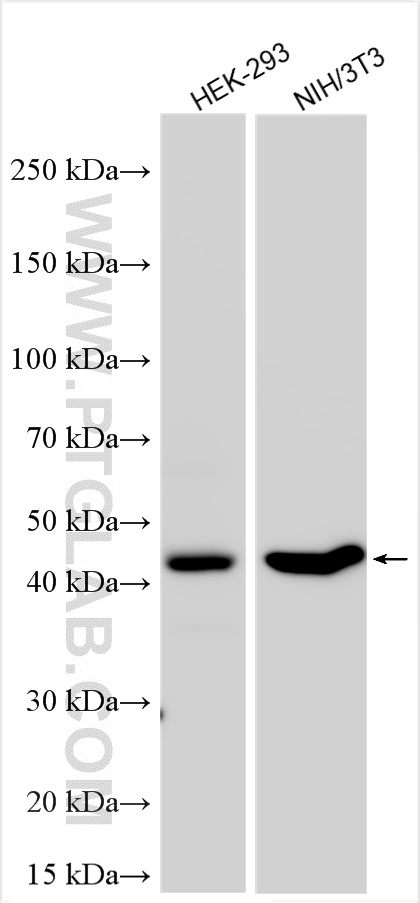验证数据展示
经过测试的应用
| Positive WB detected in | HEK-293 cells, NIH/3T3 cells |
推荐稀释比
| 应用 | 推荐稀释比 |
|---|---|
| Western Blot (WB) | WB : 1:1000-1:6000 |
| It is recommended that this reagent should be titrated in each testing system to obtain optimal results. | |
| Sample-dependent, Check data in validation data gallery. | |
产品信息
24605-1-AP targets CLN5 in WB, ELISA applications and shows reactivity with human, mouse samples.
| 经测试应用 | WB, ELISA Application Description |
| 经测试反应性 | human, mouse |
| 免疫原 |
CatNo: Ag18175 Product name: Recombinant human CLN5 protein Source: e coli.-derived, PGEX-4T Tag: GST Domain: 107-407 aa of BC153154 Sequence: KRFDFRPKPDPYCQAKYTFCPTGSPIPVMEGDDDIEVFRLQAPVWEFKYGDLLGHLKIMHDAIGFRSTLTGKNYTMEWYELFQLGNCTFPHLRPEMDAPFWCNQGAACFFEGIDDVHWKENGTLVQVATISGNMFNQMAKWVKQDNETGIYYETWNVKASPEKGAETWFDSYDCSKFVLRTFNKLAEFGAEFKNIETNYTRIFLYSGEPTYLGNETSVFGPTGNKTLGLAIKRFYYPFKPHLPTKEFLLSLLQIFDAVIVHKQFYLFYNFEYWFLPMKFPFIKITYEEIPLPIRNKTLSGL 种属同源性预测 |
| 宿主/亚型 | Rabbit / IgG |
| 抗体类别 | Polyclonal |
| 产品类型 | Antibody |
| 全称 | ceroid-lipofuscinosis, neuronal 5 |
| 别名 | EC:2.3.1.-, Ceroid lipofuscinosis neuronal protein 5, BMPS, BMP synthase CLN5, Bis(monoacylglycero)phosphate synthase CLN5, secreted form |
| 计算分子量 | 407 aa, 46 kDa |
| 观测分子量 | 48 kDa |
| GenBank蛋白编号 | BC153154 |
| 基因名称 | CLN5 |
| Gene ID (NCBI) | 1203 |
| RRID | AB_3662025 |
| 偶联类型 | Unconjugated |
| 形式 | Liquid |
| 纯化方式 | Antigen affinity purification |
| UNIPROT ID | O75503 |
| 储存缓冲液 | PBS with 0.02% sodium azide and 50% glycerol, pH 7.3. |
| 储存条件 | Store at -20°C. Stable for one year after shipment. Aliquoting is unnecessary for -20oC storage. |
背景介绍
The CLN5 (ceroid lipofuscinosis neuronal protein 5) protein is ubiquitously expressed in the majority of tissues studied and in the brain, CLN5 shows both neuronal and glial cell expression. CLN5 plays a role in maintaining an acidic environment in the lysosomes, a critical feature for a functional lysosome (PMID: 38236309). Moreover, CLN5-deficient neuronal progenitor cells showed reduced thioesterase activity, confirming the live cell function of CLN5 in setting S-depalmitoylation levels (PMID: 35427157).
实验方案
| Product Specific Protocols | |
|---|---|
| WB protocol for CLN5 antibody 24605-1-AP | Download protocol |
| Standard Protocols | |
|---|---|
| Click here to view our Standard Protocols |
